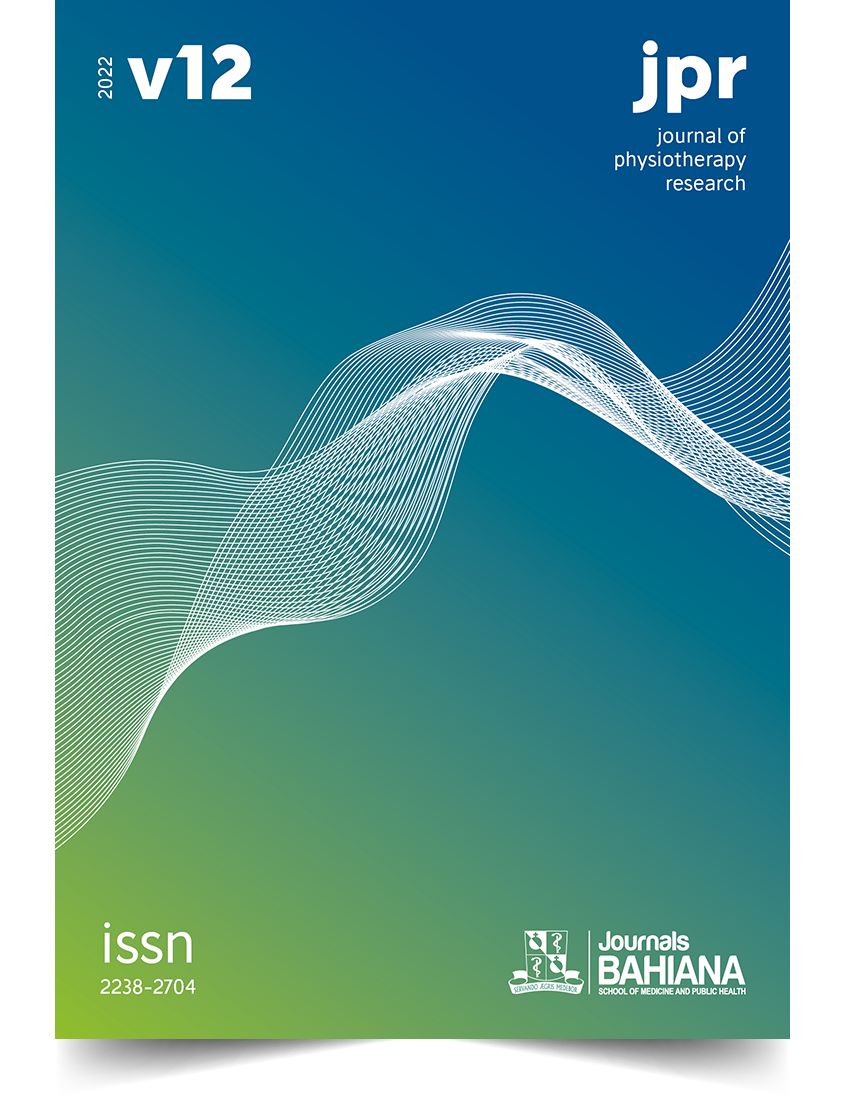Pilot study on lumbar canal diameter and walking distance in patients with lumbar spinal stenosis: a multivariate prediction model
DOI:
https://doi.org/10.17267/2238-2704rpf.2022.e4827Keywords:
Lumbar vertebrae, Magnetic resonance imaging, Neurogenic claudication, Spinal stenosis, WalkingAbstract
INTRODUÇÃO: A claudicação neurogênica (NC) é a apresentação clínica clássica de pacientes com Estenose Espinhal Lombar (EEL). Esses pacientes podem ou não apresentar sintomas de dor nas pernas e dificuldade para caminhar. Esses sintomas são exacerbados ao caminhar e ficar em pé e são aliviados ao sentar ou inclinar-se para a frente. MÉTODO: Pacientes com EEL, com diâmetro do canal lombar menor ou igual a 12mm, foram recrutados em um hospital terciário reconhecido. As características demográficas e antropométricas de cada sujeito foram anotadas e o procedimento do teste foi explicado. O diâmetro do canal foi documentado com a ajuda de um relatório de ressonância magnética. Um teste de caminhada individualizado foi usado para avaliar a distância percorrida. ANÁLISE ESTATÍSTICA: Dependendo da normalidade dos dados, o coeficiente de correlação de Pearson (r) foi usado para encontrar a correlação entre o diâmetro do canal em diferentes níveis lombares e a distância percorrida em pacientes com EEL. RESULTADO: O coeficiente de correlação de Pearson (r) determinou uma correlação positiva razoável (r = 0,29) entre o diâmetro do canal lombar e a distância percorrida. Análise de regressão múltipla stepwise foi feita, e uma equação de predição foi encontrada para diferentes níveis de estenose do canal. CONCLUSÃO: Os achados de nosso estudo sugerem uma correlação positiva razoável entre a distância percorrida e o diâmetro do canal em L5-S1. Este estudo também pode ser útil para prever o diâmetro aproximado do canal, estimando a distância percorrida pelo paciente com sintomas de EEL e vice-versa.
Downloads
References
(1) Wei W, Xu C, Yang XJ, Lu CB, Lei W, Zhang Y. Analysis of Dynamic Plantar Pressure before and after the Occurrence of Neurogenic Intermittent Claudication in Patients with Lumbar Spinal Stenosis: An Observational Study. Biomed Res Int. 2020;2020:5043583. https://doi.org/10.1155/2020/5043583
(2) Grelat M, Gouteron A, Casillas JM, Orliac B, Beaurain J, Fournel I, et al. Walking Speed as an Alternative Measure of Functional Status in Patients with Lumbar Spinal Stenosis. World Neurosurg. 2019;122:591-97. https://doi.org/10.1016/j.wneu.2018.10.109
(3) Anasuya DG, Jayashree A, Moorthy NLN, Madan S. Anatomical study of lumbar spinal canal diameter on MRI to assess spinal canal stenosis. Int J Anat Res. 2015;3(3):1441-44. http://www.ijmhr.org/ijar.3.3/IJAR.2015.261.html
(4) Dutta S, Bhave A, Patil S. Correlation of 1.5 Tesla magnetic resonance imaging with clinical and intraoperative findings for lumbar disc herniation. Asian Spine J. 2016;10(6):1115-21. https://doi.org/10.4184%2Fasj.2016.10.6.1115
(5) Elhassan YAM, Ahmed AO, Ali QM, Handady SOM. Clinical Presentation of Lumbosacral Spinal Canal Stenosis Among Sudanese Patients. Glob J Orthop Res. 2019;1(3). http://dx.doi.org/10.33552/GJOR.2019.01.000512
(6) Bumann H, Nüesch C, Loske S, Byrnes SK, Kovacs B, Janssen R, et al. Severity of degenerative lumbar spinal stenosis affects pelvic rigidity during walking. Spine J. 2020;20(1):112-20. https://doi.org/10.1016/j.spinee.2019.08.016
(7) Comer CM, Redmond AC, Bird HA, Conaghan PG. Assessment and management of neurogenic claudication associated with lumbar spinal stenosis in a UK primary care musculoskeletal service: A survey of current practice among physiotherapists. BMC Musculoskelet Disord. 2009;10:121. https://doi.org/10.1186/1471-2474-10-121
(8) Ahmad T, Goel P, Babu CSR. A study of lumbar canal by M.R.I. in clinically symptomatic and asymptomatic subjects. J Anat Soc India. 2011;60(2):184–7. https://doi.org/10.1016/S0003-2778(11)80022-5
(9) Ammendolia C, Chow N. Clinical outcomes for neurogenic claudication using a multimodal program for lumbar spinal stenosis: A retrospective study. J Manipulative Physiol Ther [Internet]. 2015;38(3):188–94. http://dx.doi.org/10.1016/j.jmpt.2014.12.006
(10) Jain N, Acharya S, Adsul NM, Haritwal MK, Kumar M, Chahal RS, et al. Lumbar canal stenosis: A prospective clinicoradiologic analysis. J Neurol Surgery, Part A Cent Eur Neurosurg. 2020;81(5):387–91. https://doi.org/10.1055/s-0039-1698393
(11) Tomkins CC, Battié MC, Rogers T, Jiang H, Petersen S. A criterion measure of walking capacity in lumbar spinal stenosis and its comparison with a treadmill protocol. Spine (Phila Pa 1976). 2009;34(22):2444–9. https://doi.org/10.1097/brs.0b013e3181b03fc8
(12) World Medical Association. Declaration of Helsinki, ethical principles for scientific requirements and research protocols. Bull World Health Organ. 2001;79(4):373-74. Cited: PMID: 11357217
(13) Portney LG, Watkins MP. Foundations of clinical Research applications to practice. 3th ed. C.A.Davis; 2015.
(14) Fors M, Enthoven P, Abbott A, Öberg B. Effects of pre-surgery physiotherapy on walking ability and lower extremity strength in patients with degenerative lumbar spine disorder: Secondary outcomes of the PREPARE randomised controlled trial. BMC Musculoskelet Disord. 2019;20:468. https://doi.org/10.1186/s12891-019-2850-3
(15) Gaur P, Goyal M, Singh G. Manual therapy and canal enlargement exercises versus conventional physiotherapy in lumbar stenosis – a study protocol. Rev Pesqui Fisioter. 2021;11(3):549-60. https://doi.org/10.17267/2238-2704rpf.v11i3.3864
(16) Kuittinen P, Sipola P, Saari T, Aalto TJ, Sinikallio S, Savolainen S, et al. Visually assessed se verity of lumbar spinal canal stenosis is paradoxically associated with leg pain and objective walking ability. BMC Musculoskelet Disord. 2014;15:348. https://doi.org/10.1186/1471-2474-15-348
(17) Lee BH, Moon SH, Suk KS, Kim HS, Yang JH, Lee HM. Lumbar Spinal Stenosis: Pathophysiology andTreatment Principle: A Narrative Review. Asian Spine J. 2020;14(5):682–93. https://doi.org/10.31616%2Fasj.2020.0472
(18) Lai MKL, Cheung PWH, Samartzis D, Cheung JPY. Prevalence and Definition of Multilevel Lumbar Developmental Spinal Stenosis. Glob Spine J. 2022;12(6):1084-90. https://doi.org/10.1177%2F2192568220975384
(19) Mahato NK. Disc spaces, vertebral dimensions, and angle values at the lumbar region: a radioanatomical perspective in spines with L5-S1 transitions. J Neurosurg Spine. 2011;15(4):371-79. https://doi.org/10.3171/2011.6.spine11113
(20) Hirano K, Imagama S, Hasegawa Y, Muramoto A, Ishiguro N. Impact of spinal imbalance and BMI on lumbar spinal canal stenosis determined by a diagnostic support tool: cohort study in community-living people. Arch Orthop Trauma Surg. 2013;133(11):1477-82. https://doi.org/10.1007/s00402-013-1832-4
(21) Samartzis D, Karppinen J, Chan D, Luk KDK, Cheung KMC. The association of lumbar intervertebral disc degeneration on magnetic resonance imaging with body mass index in overweight and obese adults: a population-based study. Arthritis Rheum. 2012;64(5):1488-96. https://doi.org/10.1002/art.33462
(22) Andrasinova T, Adamova B, Buskova J, Kerkovsky M, Jarkovsky J, Bednarik J. Is there a correlation between degree of radiologic lumbar spinal stenosis and its clinical manifestation? Clin Spine Surg. 2018;31(8):403-08. https://doi.org/10.1097/bsd.0000000000000681
Downloads
Published
Issue
Section
License
Copyright (c) 2022 Gurjant Singh, Aksh Chahal, Manjeet Singh

This work is licensed under a Creative Commons Attribution 4.0 International License.
This work is licensed under a Creative Commons Attribution 4.0 International License.



